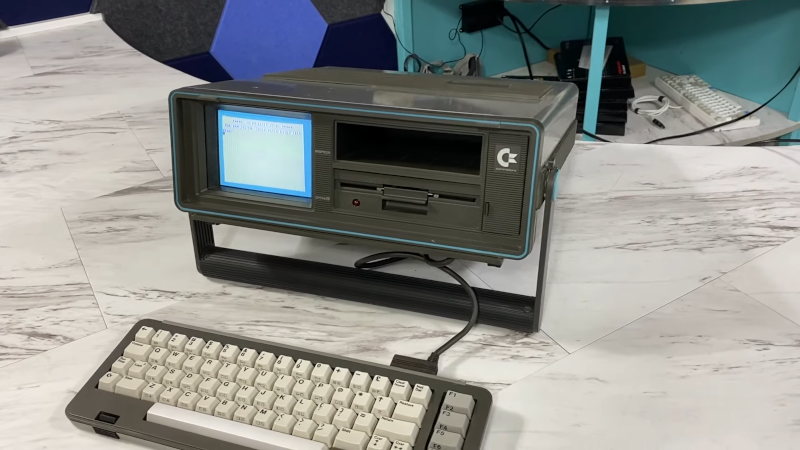When you think of a luggable computer, you might think of the old Compaq or — if you are old enough — a Kaypro. But you don’t see as many Commodore SX-64 computers. [The 8-Bit Guy] has wanted one for a while and finally got one, but it wasn’t working. No problem! Just fix it!
The device actually looks sleek compared to some other portables of the era and had a color screen, but — probably due to the price — they didn’t sell very well. The outside of the device looked pretty clean other than some loose screws and clips. The space key was quite yellow but at least there was a keyboard cable which is nearly impossible to find anymore.
Turning it on just showed a white raster on the screen. The teardown is interesting. There’s quite a bit packed inside the little case. Of course, that means you have to pull the five boards out to get to them.
Removing the case caused the display to change a little. He pulled the CPU board out and started swapping chips with a working Commodore 64 until he found two chips that would prevent the known good machine from working. Replacing them did the trick for the CPU, but the keyboard was still not fully functional.
That led to a teardown of the keyboard, too. Some 3D-printed latches fixed the physically broken parts. The keyboard itself is unusual with a bunch of integrated keys and keycaps and a flexible membrane that apparently is a common failure point. However, you can get replacements, but the work looks like it takes a bit of patience.
Overall, the machine looks about as good as new. However, as [The 8 Bit Guy] points out, the color monitor was never very good and he explains exactly why that is.
We’d love to score one of these machines, even though the poor screen makes them less useful than a proper C64. We’ve seen someone add a second drive to these machines. If you want more detail about restoring the SX-64 keyboard, we’ve looked at that before, too.
















Yikes. He´s opening the case and pulling boards out without removing the power cord. And the beast contains a CRT…
Well, you can’t measure power supply voltages without power. There are also just a few places on a CRT where you should not stick your fingers (screwdriver, whatever) and he’s got plenty of experience. And usually it doesn’t even kill you. It just gives a loud bang and leaves you dazed ‘n confused for some time.
But most of all. It’s a heavily edited video and all the boring parts are cut out. You can’t use that to draw such conclusions.
I would keep the “yikes” in considering his past with shorting out power supplies due to lack of care. He’s got plenty of experience, but not a lot of wisdom.
We’re talking The8bitguy here, the ‘vitriol’ is justified
Really not as dangerous as it’s cracked up to be. I do it all the time. Just know your high voltage habits
Not a big deal on this machine. Unlike PC’s, there aren’t any “stand by” power rails on the C64 and I’m pretty sure he’s familiar with the dangers of CRT’s.
“It is often used where the word “but” would be correct. There seems to be some kind of prejudice against using a simple, correct word.”
>>
It is often used where the word “but” would be correct, however there seems to be some kind of prejudice against using a simple, correct word.
Another thing he missed to mention is the cartridge system.
For a lugable brick you would at least expect those to be fully inside the box.
But the combination of very small CRT and bad quality shadow mask would have been enough to push this into a niche market.
he mentions it…
The shadow mask on those CRTs is about half the color resolution of the C64 system.
there’s a monitor output on the back of the case so you can connect a C64 monitor for that large screen experience, I had one for several years, foolishly sold it and always regretted it.
But you used it five times!
Price may have been a factor, but also, the SX-64 was in a format almost exclusively associated with business machines, and the Commodore 64 definitely wasn’t the natural choice for that. Even with GEOS, which the SX-64 predated by 2 years in any case, it would have been a hard sell for business use. It was just such a bizarrely misaimed product; all I can assume is that an engineer at Commodore went “you know what’d be really neat?” and the company ran with it. Because after all, it *is* a thing of beauty. Wild, impractical beauty.
He mentioned in the video that Commodore was considering a model with a B&W monitor, which would have been much sharper. Maybe if someone finds an SX-64 with a dead CRT a B&W replacement might be interesting.
I used to service those units. May even have a spare monitor from one. I know I have a complete unit in the back of my storage unit, but it’s been sitting on concrete for upwards of 20 + years… so how functional.. no clue. I had adapted the monitor as a small service monitor as it had composite input. (Don’t recall if I just had soldered the wires.. probably did)
‘Techmoan’ on YouTube did a great video on this a while back. Worth a look:
https://www.youtube.com/watch?v=lXlblGvNtOs
Nice machine, I have 8 sx-64s all in great shape.